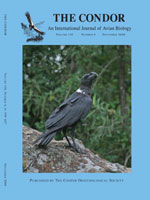We investigated molted-feather persistence and aging in a sub-Arctic environment by placing marked feathers at historical Gyrfalcon (Falco rusticolus) nesting areas and returning a year later to collect and inspect remaining feathers. After one year, only 14% of marked feathers remained and were collected during primary searches; small, body feathers were significantly less likely to persist than large or flight feathers. No differences in trends were detected between feathers from perch and below-nest locations. All recovered feathers displayed at least one of three signs of aging (matted and separated barbs, fungal growth, or algal growth) that reliably distinguished them from fresh feathers. We show that collection efforts should focus on small, body feathers to ensure that collected feathers are freshly molted and suggest feather persistence and aging be directly addressed in other studies using feathers for noninvasive genetic sampling. Doing so should reduce potential genotyping and data interpretation errors, help meet capture-mark-recapture assumptions, and increase confidence in results.
How to translate text using browser tools
1 November 2008
Molted-Feather Persistence and Aging in a Sub-Arctic Environment: Implications for Noninvasive Genetic Sampling
Travis Booms,
Brian McCaffery,
Phil Schempf
ACCESS THE FULL ARTICLE

The Condor
Vol. 110 • No. 4
November 2008
Vol. 110 • No. 4
November 2008
capture-mark-recapture
conservation genetics
Falco rusticolus
feather persistence
gyrfalcon
noninvasive genetic sampling




